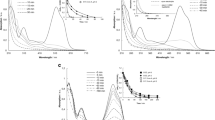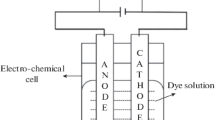Abstract
The aim of this work was to evaluate the possibility of decolorization of effluents that contain structurally different azo and aminoantrachinone dyes. The decolorization was performed by an indirect electrochemical oxidation in a single-chamber laboratory electrolyzer under galvanostatic mode. Anodes used for the treatment were a planar boron-doped diamond and a platinum electrode. The changes in decolorization rate of model solutions were measured during indirect electrochemical oxidation in dependence on different initial pH in the presence of sodium sulfate, which is frequently used during the dyeing process. The decolorization process was compared with another abundant salt, specifically sodium chloride. The time intervals corresponding to chromaticity change of electrolyzed solution were measured and kinetic constants were assessed. Results showed that the decolorization rate is higher in the presence of NaCl than Na2SO4 and the structure of the dye has a direct impact on the velocity of the decolorization process. However, the degradation evaluated by the determination of total organic carbon parameter showed promising results also in the presence of sulfates on the boron-doped diamond anode dropping from 104 to 21 mg dm−3. Since this parameter decreased on Pt anode only to 98 mg dm−3, boron-doped diamond anode showed better performance in the presence of sulfates.
Graphical abstract








Similar content being viewed by others
References
Nidheesh PV, Zhou M, Oturan MA (2018) Chemosphere 197:210
Comninellis CH, Kapalka A, Malato S, Parsons SA, Poulios I, Mantzavinos D (2008) J Chem Technol Biotechnol 83:769
Souza FL, Lanza MRV, Llanos J, Sáez C, Rodrigo MA, Cañizares P (2015) J Environ Manage 158:36
Chaplin BP (2014) Environ Sci Processes Impacts 16:1182
Hupert M, Muck A, Wang J, Stotter J, Cvackova Z, Haymond S, Show Y, Swain GM (2003) Diam Relat Mater 12:1940
Martínez-Huitle CA, Rodrigo MA, Sirés I, Scialdone O (2015) Chem Rev 115:13362
Farhat A, Keller J, Tait S, Radjenovic J (2015) Environ Sci Technol 49:14326
Divyapriya G, Nidheesh PV (2021) Curr Opin Solid State Mater Sci 25:100921
Chen L, Lei CH, Li Z, Yang B, Zhang X, Lei L (2018) Chemosphere 210:516
Olmez-Hanci T, Arslan-Alaton I (2013) Chem Eng J 224:10
Guerra-Rodríguez S, Rodríguez E, Singh DN, Rodríguez-Chueca J (2018) Water 10:1828
Song H, Yan L, Jiang J, Ma J, Zhang Z, Zhang J, Liu P, Yang T (2018) Water Res 128:393
Zhang T, Chen Y, Wang Y, Le Roux J, Yang Y, Croué JP (2014) Environ Sci Technol 48:5868
Giannakis S, Lin KYA, Ghanbari F (2021) Chem Eng J 406:127083
Mackuľak T, Vojs M, Grabic R, Golovko O, Vojs Staňová A, Birošová L, Medveďová A, Híveš J, Gál M, Kromka A, Hanusová A (2016) Monatsh Chem 147:97
Candia-Onfray CH, Espinoza N, Silva EBS, Toledo-Neira C, Espinoza LC, Santander R, García V, Salazar R (2018) Chemosphere 206:709
Bagastyo AY, Batstone DJ, Rabaey K, Radjenovic J (2013) Water Res 47:242
Domínguez JR, González T, Correia S (2021) J Environ Manage 298:113538
Ammar HB, Brahim MB, Abdelhédi R, Samet Y (2016) Sep Purif Technol 157:9
Murugananthan M, Latha SS, Raju GB, Yoshihara S (2011) Sep Purif Technol 79:56
Lan Y, Coetsier C, Causserand CH, Serrano KG (2017) Electrochim Acta 231:309
Radjenovic J, Petrovic M (2017) J Hazard Mater 333:242
Titchou FE, Zazou H, Afanga H, Gaayda JE, Akbour RA, Hamdani M, Oturan MA (2021) J Electroanal Chem 897:115560
Alcocer S, Picos A, Uribe AR, Pérez T, Peralta-Hernández JM (2018) Chemosphere 205:682
Yaseen D, Scholz M (2019) Int J Environ Sci Technol 16:1193
Delory GE, King EJ (1945) Biochem J 39:245
Boni JE, Brickl RS, Dressman J (2007) J Pharm Pharmacol 59:1375
Hammett LP (1937) J Am Chem Soc 59:96
Kuchtová G, Chýlková J, Váňa J, Vojs M, Dušek L (2020) J Electroanal Chem 863:114036
Song H, Yan L, Ma J, Jiang J, Cai G, Zhang W, Zhang Z, Zhang J, Yang T (2017) Water Res 116:182
Farhat A, Keller J, Tait S, Radjenovic J (2018) Electrochem Commun 89:14
Dušek L (2010) Chem Listy 104:846
Kapałka A, Fóti G, Comninellis CH (2008) J Appl Electrochem 38:7
Fabiańska A, Ofiarska A, Fiszka-Borzyszkowska A, Stepnowski P, Siedlecka EM (2015) Chem Eng J 276:274
Farhat A, Keller J, Tait S, Radjenovic J (2017) Chem Eng J 330:1265
Acknowledgements
We are grateful to prof. Ing. Ladislav Novotný, DrSc., Dr. for discussions and to the Student Grant Competition 2021 (SGS_2021_003) for financial support.
Author information
Authors and Affiliations
Corresponding author
Additional information
Publisher's Note
Springer Nature remains neutral with regard to jurisdictional claims in published maps and institutional affiliations.
Rights and permissions
About this article
Cite this article
Kuchtová, G., Mikulášek, P. & Dušek, L. The role of dye’s structure on the degradation rate during indirect anodic oxidation. Monatsh Chem 153, 237–243 (2022). https://doi.org/10.1007/s00706-022-02897-w
Received:
Accepted:
Published:
Issue Date:
DOI: https://doi.org/10.1007/s00706-022-02897-w




